Key Takeaways
silk comes from the silkworm, an insect that feeds on mulberry leaves to produce its cocoon. silkworm breeding called sericulture is practiced in magnaneries and requires mulberry leaves in abundance.
The main silk producing countries in the world are China, India, Brazil, Vietnam, Uzbekistan and Thailand. France also has a long sericulture tradition.
The manufacture of silk from cocoons includes several stages such as spinning, weaving, dyeing and confection.
The French brand The Oversized Hoodie® 🇫🇷 is famous for its textile expertise, particularly its collection of high-end, 100% natural mulberry silk products certified Oeko-Tex® Standard 100.
Free from toxic and chemical substances, and ecological, the collections pillowcase 100% silk, 100% silk sleep mask and silk sheets stand out for their incomparable softness and excellent value for money, providing an unrivaled feeling of comfort.
Origin and history of silk
The story of the silkworm
The silkworm (Bombyx mori) is a domesticated insect whose breeding dates back thousands of years. Legend has it that the discovery of silk dates back to 2640 BC in China, when the Empress Xi Ling Shi accidentally dropped a silkworm cocoon in his cup of hot tea. By wanting to remove it, she would then have unwound the first silk thread.
Silk through the ages
The Silk Road, a famous trade route between Asia and Europe operational since the 1st century BC, owes its name to the trade in silk which there was in transit. Silk was then a luxury good reserved for the elite.
The secret of making silk will be jealously guarded by the Chinese for centuries before spreading. Silkworm breeding would have been introduced by Nestorian monks in Byzantium in the 6th century.
The role of silk in world history
The spread of sericulture outside China from the Middle Ages had a considerable economic and cultural impact. Entire cities in Italy, Spain and France became rich thanks to the silk trade.
The silk industry also contributed to cultural and scientific exchanges between China and the West, notably through the importation of the mulberry tree necessary for breeding the worm.
Also read: Which country invented silk ?
Sericulture: breeding of silkworms
What is sericulture ?
sericulture is the breeding of the silkworm with the aim of harvesting the cocoons to extract the precious thread and produce silk textiles. This activity requires large quantities of mulberry leaves to feed the caterpillars.
The life cycle of the silkworm
The silkworm cycle begins with the hatching of bombyx mori butterfly eggs laid on mulberry leaves.The caterpillars grow by consuming the leaves before weaving their cocoon into silk thread. Inside, they begin their metamorphosis into a chrysalis before becoming a butterfly.
What is the name of the silkworm breeder ?
The silkworm breeder is called magnanier. Its activity consists of raising worms in a silkworm farm and providing an abundance of mulberry leaves necessary for their growth.
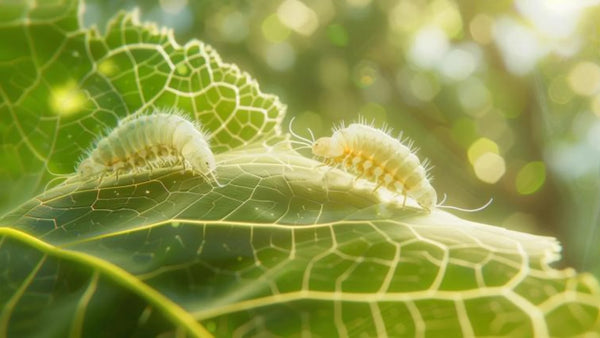
Also read: What is the name of the silkworm breeder ?
Places of silk production
Silk in Asia: China and Korea
China is by far the world's leading producer of silk. The province of Zhejiang concentrates 40% of production, with cities like Hangzhou or Ningbo renowned for their silks.
South Korea is also an important producer, notably of the precious wild silk woven from the cocoons of the naturally living silkworm.

During a recent trip to China, I had the chance to visit a mulberry plantation and a magnanerie. I was fascinated to discover the complex process of rearing of silkworms and harvesting their precious cocoons.
In talking with the owner, Mr. Wu, I understood to what extent perpetuating this ancestral know-how was vital to him. “My family has been raising silkworms for 7 generations. I want to pass this tradition on to my children,” he told me.
This passion for the craft and attention to detail shines through in the high-quality silk that he produces. After this enriching visit, I will never see a silk garment in the same way again!
Silk in Europe: Greece and Austria-Hungary
In Europe, Greece was a major producer of silk in the past. Soufli was thus nicknamed the “city of silk”. Today, production has fallen sharply.
Austria-Hungary was also a stronghold of sericulture, particularly in its southern part in Croatia and Slovenia.
Silk in America and elsewhere in the world
Brazil and Argentina dominate silk production in Latin America. The region of Maringá in Brazil concentrates numerous plantations of mulberry trees and magnaneries.
In Asia, in addition to China, Vietnam, India, Uzbekistan and Thailand are among the main silk producing countries.
Silk manufacturing: the detailed process
From chenille to silk thread: the manufacturing process
Once the cocoons are harvested, they are immersed in hot water to allow the unwinding of the silk threads stuck together by the sericin. This raw thread is then twisted to obtain a regular continuous thread.
Next generally comes the dyeing step to obtain the desired color. Finally, the silk thread is ready for weaving on a loom to produce different types of fabrics or silk fabrics.
How is silk made today ?
With mechanization, the silk production process is today largely automated and industrialized, allowing large-scale manufacturing.
However, certain aspects such as cocoon harvesting or traditional weaving by hand still exist, particularly for high-end artisanal silks.
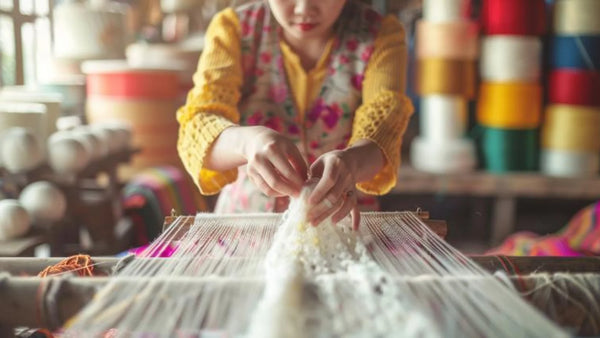
Also read: How is silk made ?
Where the mulberry tree grows ?
The mulberry tree, a tree whose leaves feed silkworms, grows in temperate to tropical regions of the globe.
It is found abundantly in Asia in countries such as China, India, Thailand and even Thailand Vietnam and Japan which are among the largest silk producers in the world.
In Europe, the mulberry grows mainly in the Mediterranean basin, for example in Italy, Spain and Greece where sericulture was prosperous in the past.
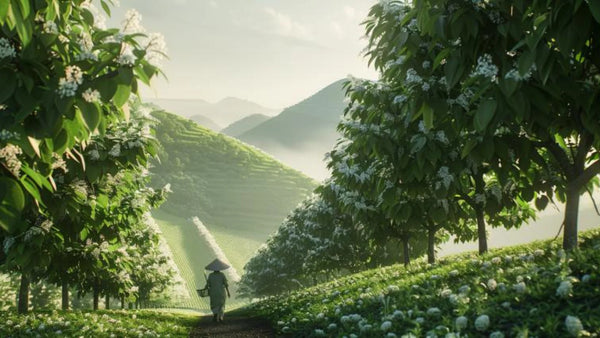
Types of silk: diversity and use
Diversity of silk types
There are many types of silk depending on factors such as the species of silkworm (bombyx, tussah...), the breeding method (wild silk), the region of production (imperial Chinese silk , Bengal silk...), the treatments (dyeing, scouring...) or even the final appearance (crepe de Chine, satin, velvet...).
At The Oversized Hoodie®, we attach great importance to the quality and traceability of the raw materials used. This is why we recommend favoring certified and labeled silks as much as possible, a guarantee of high standards and responsible practices.
— Geoffrey, Founder of The Oversized Hoodie®
The varied uses of silk
Silk is used in the textile industry and haute couture for making clothes (dresses, ties, etc.), accessories (scarves, shawls, etc.) and
lingerie.
It is also used in the composition of high-end products such as bedding sets (sheets, silk scrunchies, silk duvets, etc.) or oriental carpet.
Also read: What are the different types of silk ?
Where do silkworms live ? Conditions necessary for their breeding
Silkworms must live in a warm and humid environment for their optimal development. breeding takes place in buildings called magnaneries where temperature and humidity can be controlled.
The main conditions are:
- Temperature between 20°C and 25°C
- High humidity in the range of 70 to 85%
- Total darkness or very low brightness
- Strict cleanliness and hygiene
Regular and abundant intake of fresh mulberry leaves is of course vital. At their final stage, the worms are placed on racks to weave their cocoons.
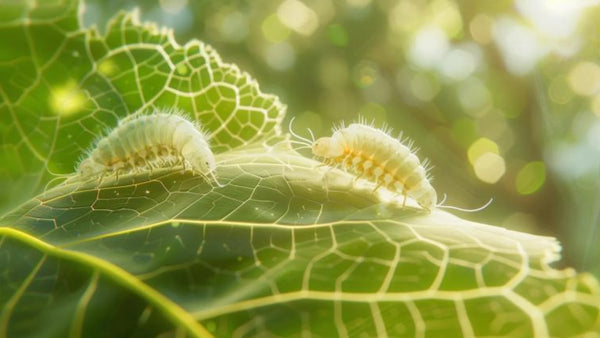
Also read: Where the silkworm lives ?
The silk tree: a key element in silk production
The importance of the mulberry in silkworm breeding
The white mulberry (Morus alba) is vital for silkworm breeding because its leaves constitute the caterpillar's only food. A regular and quantitative supply is essential for the proper development of the larvae and the production of quality cocoons.
How to cultivate a mulberry tree for silkworm breeding ?
The cultivation of mulberry requires rich soil and well drained, mild temperatures and sunny exposure. Pruning and staking are important to promote rapid growth and optimal production of tender leaves that silkworms love.
Silk in France: history and current affairs
Silk production in France: past and present
France was among the first European countries to adopt sericulture in the Middle Ages. Cities like Lyon or Nîmes became renowned centers of silk production and trade.
Today there are a few artisanal breeding farms perpetuating the tradition, but French production no longer has much weight compared to Asia. Efforts are being made to revive and modernize the sector.
The future of silk in France: innovations and challenges
Research institutes such as INRAE are working to improve breeding techniques and mulberry varieties. The challenge is to make French sericulture more competitive compared to major Asian producing countries.
traceability and labeling procedures are also an area of development to promote high-end French silk.
As the founder of The Oversized Hoodie®, I am fascinated by the history and artisanal processes linked to silk production. According to my experience in the textile sector, perpetuating this ancestral know-how while innovating is the key to perpetuating the sericulture sector.
— Geoffrey, Founder of The Oversized Hoodie®
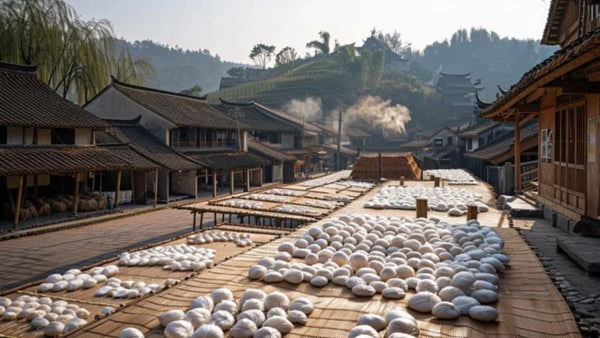
Also read: Where is silk produced in France ?
Silk in the world: producing and consuming countries
Who are the largest silk producers in the world ?
Without doubt, China outrageously dominates world silk production. It alone provides approximately 75 to 80% of total production.
India ranks a distant second. Then come Vietnam, Brazil, Uzbekistan, Thailand and South Korea which complete the top of the main producing countries of silk in the world.
Which countries consume the most silk ?
The largest consumers of silk are generally developed and rich countries. Europe (France, Italy, Switzerland, etc.), the United States and Japan are among the most promising markets for textiles and luxury clothing in silk.
Demand is also strong in emerging countries where a wealthy middle class is emerging, eager to imitate Western consumption patterns. This is the case of China, but also of India, of Russia, of Brazil or even of countries of the Gulf.
Conclusion
silk has fascinated men for millennia with its unique and refined texture. Behind this precious thread hides a whole little-known world: that of the silkworm and its breeding, sericulture.
If China has long retained a monopoly on this know-how, silk has spread to the four corners of the world over the centuries. Today, Asia largely dominates production, even if countries like Brazil or Uzbekistan hold their place.
Used in the luxury industry, but also for innovative technical applications, silk still has a bright future ahead of it, provided that sericultural know-how is preserved and develop a sustainable sector.
| Appearance | Description |
|---|---|
| Origin | Silk comes from the silkworm, bred mainly for its ability to produce the cocoon from which the silk thread is extracted. |
| Main producers | China, India, Brazil, Vietnam, Uzbekistan, Thailand. |
| Manufacturing | Includes spinning, weaving, dyeing and making from cocoons. |
| Uses | Luxury textiles, haute couture, accessories, bedding, and oriental rugs. |
| Rearing conditions | Hot and humid environment, with a diet based on mulberry leaves. |
| Types of silk | Diversity based on silkworm species, breeding method, and production region. |
| Silk in France | Ancient sericulture tradition, with limited current production but efforts to revive the sector. |
| World market | China dominates production. Developed and rich countries are the main consumers. |
FAQ
Where does the silk come from ?
silk originally comes from China, where the breeding of the silkworm is said to have begun nearly 5,000 years ago. Legend has it that it was Empress Xi Ling Shi who discovered silk when she accidentally dropped a cocoon into her teacup.
Where silk is grown ?
silk is cultivated mainly in Asia, notably in China, in India, in Vietnam , in Thailand and in South Korea. These countries provide ideal conditions in terms of climate and availability of mulberry leaves to feed silkworms.
Where do silkworms live ?
The silkworms are raised in silkworms, a type of dedicated building reproducing a warm and humid environment conducive to their growth. It is found in abundance in all silk-producing countries such as China or India.
What is the country of silk ?
The country of silk par excellence is China, where the breeding of the silkworm was born almost 5,000 years ago. Even today, China is by far the world's leading producer, alone providing around 80% of the total production of silk.
How is silk made ?
silk is made from the cocoons woven by the larvae of the silkworm, the caterpillar of the bombyx. The cocoons are harvested then immersed in hot water to extract the long clumped silk threads. These threads are then twisted together to form a single continuous and regular thread ready to be woven.
What is the best silk ?
The best silk is generally considered to be wild silk, produced from the cocoons of the naturally living silkworm. It is renowned for its great finesse, its softness and its shimmering reflections.
Among farmed silks, mulberry silk from the bombyx is the most prestigious. Chinese imperial silk also enjoys an unparalleled reputation.
How to differentiate silk ?
To differentiate an authentic silk from an imitation, there are a few simple tests:
- Rub the fabric to feel the characteristic softness
- Examine the shine
- Burn a wire, the silk sizzles and gives off the smell of burnt hair
- Carry out a water drop test, the stain spreads on synthetic
The best method, however, remains the expertise of a textile professional to identify with certainty the different types of silk.
Updated March 20, 2024






